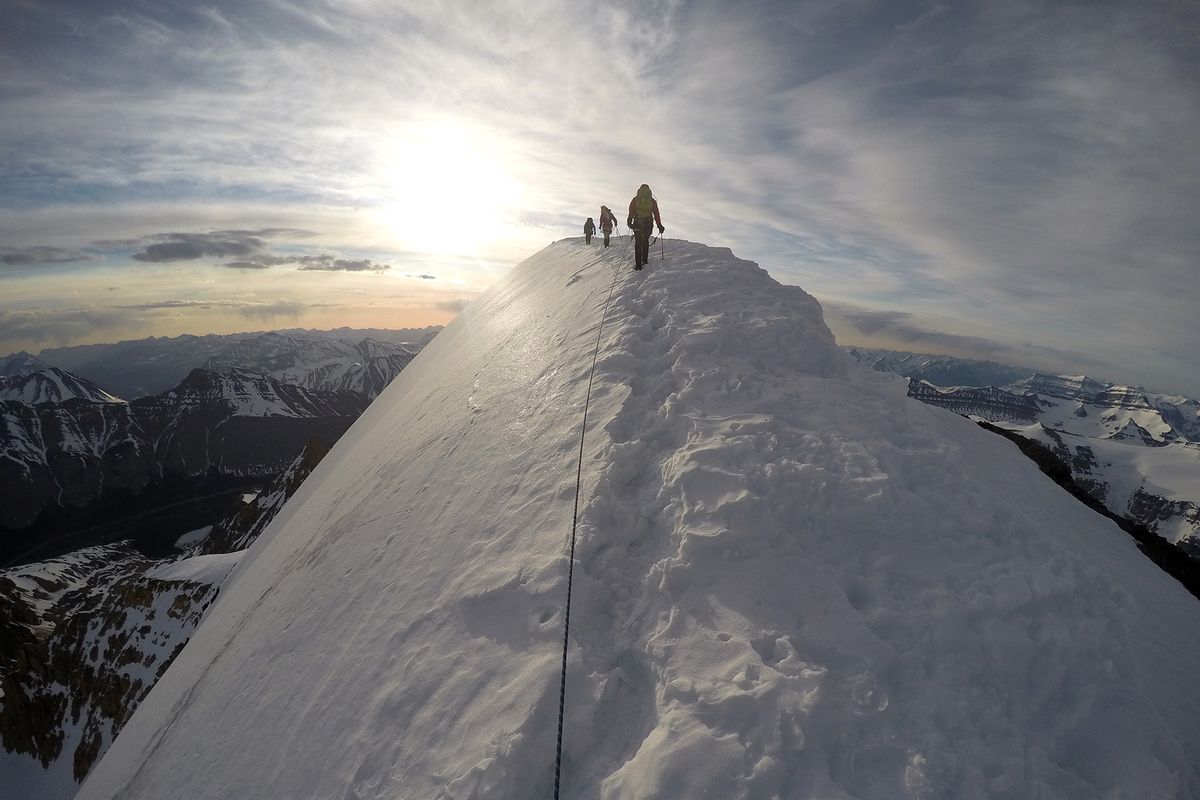Top of the world: Spokane Mountaineers club prepares climbers to reach for the sky

It would be easy to overlook the achievement of the Spokane Mountaineers marching 43 climbers to the icy 11,453-foot summit of Mount Athabasca in the Canadian Rockies last weekend.
As the world piles attention on smoke-belching clunkers that squeak and crash, the purr of a well-oiled machine often is ignored.
The club, celebrating its 100th anniversary, has been teaching mountaineering classes since 1937. The Mountain School that has evolved and improved over decades provides a comprehensive foundation for the sport of tackling remote peaks.
It’s the base that launched Spokane Mountaineers to first ascents throughout the region, followed by John Roskelley, Kim Momb and Chris Kopczynski climbing to the tops of the world in the 1960s, 70s and 80s.
Sunday’s “graduation climb,” like so many before, went off without a hitch: No injuries or rescues. No drama.
“Mountain School is a huge commitment, taught over three months, and a climb like this is the payoff,” said co-director Glenn Potter.
“We were spoiled with what might be the best weather ever for this climb,” said student climber Luke Bakken. “Hardly any wind. Warm daytime temperatures chilled out at night and the snow was firm – perfect for crampons.”
The students emerged from their tents for a midnight start and packed their gear, food and water upward. Around 6 a.m., 34 of the students reached the summit overlooking the Columbia Icefields, and then returned to camp for a 12-hour round trip.
The 18 volunteer instructors, especially the two directors, shouldered the additional weight of responsibility.
“There are a lot of logistics to make sure everybody has a safe climb,” Potter said. “There’s some heartburn involved with getting everyone into Canada and making sure they’re in tune with the potential dangers. Every climb is a round trip. No relaxing until everyone is back safely.”
“Coordinating all the instructors and activities is administratively heavy, but very rewarding,” said the other director, Matt Jeffries.
The pair began planning the Mountain School far in advance of the first classroom session in March.
Jeffries, who works for a California-based tech company, first enrolled at Mountain School in 2011, along with his wife. He was already an accomplished rock climber who joined the Mountaineers to take an ice climbing seminar.
“I took Mountain School to keep expanding my skill set and putting the pieces together,” he said.
Potter, who works with Inland Insurance, was an accomplished backpacker before signing up in 2001. “I always wanted to climb big mountains,” he said.
Jeffries is in his 20s; Potter’s in his 50s. The class included an even broader spectrum, including teens such as Grace Ford, who completed Mountain School a couple of years ago and came back this year as an instructor for the climb, just before her high school graduation.
“Mountain School has a range of ages, both men and women,” Potter said. “But this class was particularly committed, and so were the instructors who are the heart of the school.
“These folks studied hard. They were in shape.”
The school met every Wednesday for lectures and demonstrations. Students learned about gearing up, training, knots and rope management, navigation, wilderness first-aid, mountain safety and more.
Nearly every weekend, volunteer leaders taught special classes on skills such as placing anchors, belaying, rock climbing, glacier travel and crevasse rescue.
A weekend snow practice at Stevens Peak involved a 4 a.m. alpine start from camp to get used to crampons and functioning on a three-person rope team in the dark.
Another snow practice at Schweitzer forged skills such as ice axe arrest.
“They learn to think on their feet and to think ahead,” Potter said.
A thunder storm that came upon the class at Schweitzer offered an unplanned teaching moment.
“We had everyone hunkered down,” Jeffries said, noting that going onto the ridgeline to get off the mountain would have further exposed them to lightning.
“We debrief and discuss decision making after every outing,” he said.
“From the very first day, we impressed upon the students that mountaineering is an exercise in judgment and critical thinking. When you’re on a mountain, a number of factors are out of your control. You have to focus on what you can control, constantly assessing conditions and countless factors.”
Last Sunday was a perfect day for a climb, which isn’t necessarily the best scenario for a memorable learning experience. Adversity can be a good teaching tool, Potter said.
“Even in perfect weather, there was no guarantee you’d get to the top of Athabasca,” Jeffries said.
Nine climbers and instructors had to turn back on the graduation climb for one reason or another.
“Things happen,” Potter said. “You can learn a lot by turning around.”
Climbers who fail to be adequately prepared for a climb with proper equipment, training and mental attitude can learn that future climbing partners will become harder to find.
Making the decision to turn back for the safety of your rope team is a deeper lesson.
“Climbing for me has never been about the summit,” Potter said. “It’s about the experience and the journey; going as far as you can but coming back safely.”
“Getting 10 rope teams to the summit of Athabasca took a lot of commitment from a lot of people,” Jeffries said. “It was a long time coming, and that made it even sweeter.”